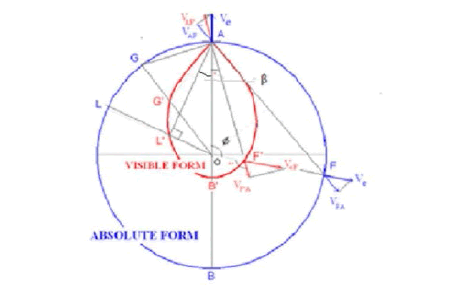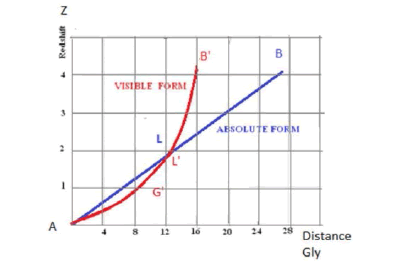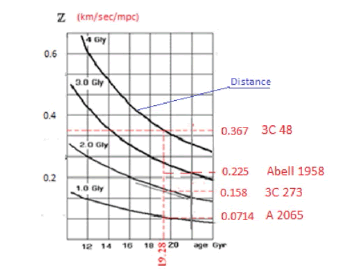Review
, Volume: 12( 3) DOI: 10.37532/2320ââ¬â6756.2023.12(3).263Age of Universe 19.28 Gyrs
- *Correspondence:
- Ozgen Ersan Member of the Aegean University Astronomy Community, Turkey,E-mail:zgnrsn@gmail.com
Received date: 15-March-2023, Manuscript No. tsse-23-91824; Editor assigned: 17-March-2023, PreQC No. tsse-23-91824 (PQ); Reviewed: 21-March -2023, QC No tsse-23-91824 (Q); Revised: 24-March-2023, Manuscript No. tsse-23-91824 (R); Published: 27-March - 2023, DOI. 10.37532/2320–6756.2023.12(3).263
Citation:Light kinematics; Simultaneity; Cosmological analysis; Relativity; Multiverse
Abstract
A four-dimensional and multi factorial detailed geometric analysis (Light Coordinate System) method is proposed to convert astronomical observation data into simultaneous values and calculate the age of the universe. With this detailed method, the age of the universe is determined as 19.28 Gyrs ± 0.50 Gyrs.
Keywords
Gravity; Electricity; Accelerations; Relativity theory
Introduction
There is a consensus that the age of the universe is 13.8 billion years [1]. However, the observation data on which this value is based are values deformed due to the finite and limited speed of light. Considering simultaneous data is a requirement of scientific integrity, and such a cosmological analysis is possible by considering some assumptions.
Literature Review
Light Coordinate System (LCS)
Processing scientific analyzes in a common framework is the gold standard and ensures equivalence/calibration of factors or physical quantities. In the case of light, which is a universal reality, this common framework must be the outermost framework capable of encompassing the relevant factors [1]. The common frame of reference for calculating the age of the universe is the allencompassing space; since the values of the astronomical parameters are obtained by the light, we may call this operation framework as "Light Coordinate System". In this method, a defined photon's emission point coordinates Pi (Xi; Yi; Zi; Ti) are marked in space or on LCS (LCS is not a tangible, but a paper surface is functional for analysis). The identified (for example numbered photon) photon moves away from this point with speed c. The light source (for example, a celestial object) has passed through this point Pi at the time of Ti and then will move away from this point Pi with the velocity Vu (Vu: the speed of the light source relative to LCS).
Age calculation mentality with Light Coordinate System (LCS) method and accompanied by some acceptances:
• Uniform expansion (big bang cosmology) model will be considered as basis [2].
• Since the general positioning of celestial objects is independent of direction (isotropic), the universe will be considered as a Multiverse -multi-cellular structure- like a clustering of interwoven soap bubbles.
• Each cell of the multiverse will be considered like the uniform expanding spherical surface [3].
• Four-dimensional geometric analysis will be performed for a single cell (the cell in which the Milky Way galaxy is located) and considered the superclusters which are the biggest structures that formed this cell.
• Since the astronomical observation data is obtained from the earth/Milky way galaxy, these data will be used assuming the Earth is supposed on the center of Virgo supercluster [4]. The effect of peculiar velocities will be evaluated within +/- tolerance/ margin of error.
• The speed of light is a finite/limited value; is fixed in vacuum (~ 300 000 km/sec.). The emitting point P (its starting coordinates) of a defined photon 2 is marked on the LCS. This photon moves away from this point P forever with its speed c. In other words: the distance between the identified photon and Point P (marked on the LCS) increases with the value “c”.
• Current paradigm and accompanied locality attitude -by mechanics habit-, they labels and uses the measured speeds of the objects by the meaning of "original relative" according to the measuring place (or first reference frame): This is valid for objects (that have mass). In the essence of "original relative speeds" mass interaction works. Majority accept that light’s source is the first reference frame for light/photon. The first reference frame of a photon is space according to LCS method [5], Besides, photon has no measurable mass, it should not be expected that light or photon behave like a massed object. Similarly, the Galilean principle of relativity (for inertial frame) and Newton's third law about action and reaction are also valid between just massed objects. If we consider/use these principles for light kinematics, we may diverge from objectivity. The relativity of the photon to a moving body should be considered as"hypothetical relativity" (e.g. as in the player-ball relationship; the velocities of the player and the ball are “original relative” velocities according to the -common framethe ground; but the distance between the ball and the player increases with the total vectorial value of these velocities).
• Space (or LCS) is the common reference/processing frame for the moving celestial bodies and test photon (light) in analysis, the Universal Velocity Value (VU) according to LCS will be used for the speed of the celestial body. The celestial body that released the photon also moves away from the photon's emission point with the speed of VU.
• Since the speed of light is a finite value, an observer positioned on the spherical surface (e.g. point A) cannot simultaneously see this spherical surface; he can see deformed shape due to NVE4. When this problem is solved by analytical or graphical method, an asymmetrical ellipsoidal surface form (like a water drop) is generated (FIG. 1).
• Observational data represent points on this asymmetric ellipsoidal surface (water drop form). These points move away from the center of the sphere with the velocity Vei. The velocity Vei of the observed objects is the universe expansion rate in ancient time in accordance with the distance. However, the universe expansion rate of the observer at the moment of observation is the current universe expansion velocity VeA.
• The radial velocity of a supercluster (that defined by its redshift value) is vectorial total5 of the projectional components of the observer's current universe expansion rate and the supercluster's past universe expansion velocity (at past) on photon's path.
• The radial velocity of the supercluster located at point L' in the apparent form of the universe is only a projectional fraction of the universe expansion rate at the time of observation (VeA.cos β)
• It will be considered as 600 million years for pure energy to become particles (partially transform into mass) and form galaxies by clumping. In this period, the universe expansion rate will be considered very close to c. In practice, this speed was used as the value c.
• When the observer is positioned at the point A on a sphere surface, the velocity of the other points moving away from A increases in direct proportion to the distance (inclined graphic in the diagram) (FIG. 2); in the form of the visible universe (on the form of water drop), the graph of the other points is curved upwards. The graph of the actual observational data available is the same. This similarity is achieved for all age values of the universe. The matching of the theoretical observational and real observational data graphs validates the LCS method.
• The astronomical data (radial velocities, distances, H0 values, etc.) for 8 Gyrs, 12 Gyrs, 16 Gyrs, 20 Gyrs, 24 Gyrs ages of the drop form (visible universe model) can be calculated theoretically. These values are diagrammed and the current age of the universe T=19.28 Gyrs is determined over the genuine observational values of some celestial bodies (FIG. 3).
The current values of theoretical astronomical data of the determined age value can be calculated and compared with the real observational data of some superclusters. The matching ones are the super clusters belonging to the universe cell on which the Milky Way is located.
• When the theoretical H0 values of the water drop form are marked according to their distances, a line graph with negative inclination is obtained. Actual observation data also varies between H0=100 km/sec/mpc-50 km/sec/mpc and almost overlaps with the theoretical H0 graphic in the same diagram. This result validates the LCS method [6].
• It is understood that the real observational H0 values (H0= ~ 100 km/sec/mpc–50 km/sec/mpc) are formed as a result of the deformation of the spherical form, which is an absolute or single value (HA=43.7 km/sec/mpc). The HA, which is the single value for God's eye, varies interval 100 and 50 for observers due to NVE.
• The HA values of the points belonging to the Absolute form of the universe (sphere surface) are constant and its graph is horizontal line (HA=43.7 km/sec/mpc for T=19.28 Gyrs. The graph of apparent universe H0 values (by distances) for the same age is a line with a negative inclination. The probability that the observation location (Earth) is not in the center of the super cluster, which is the calculation units, the effect of peculiar velocities and similar factors in the age calculation has been roughly preferred as ± 0.50 Gyrs.
• LCS method can provide control and revision opportunity for distances of some celestial bodies calculated by other methods.
Discussion
• Considering only the data supporting the hypothesis in scientific research experiments is inappropriate and may be labeled as cheating. If the universe formed as a result of the big bang was a single sphere or cake model, it would be inappropriate to choose/prefer the data supporting the hypothesis. Since the universe model of this study is determined as a multi-cell interwoven soap bubble, there is no problem in preferring real observation data supporting the hypothesis. This status may even confirm the multiverse intuition. In my opinion, the proposal of multiverse structuring similar to the interwoven multicellular soap bubbles community can be used to explain the collisions of some celestial bodies moving away from each other despite great distances, the expanding cake-like allegory and in some regions partly condensations (filament structuring) [7].
• This analysis contains assumptions in the elementary sense. There can be a wide variety of hypotheses on the same subject; in science, and new opinion is built on those that are least rejected [8].
• The special theory of relativity (SR) does not allow cosmological analysis; because, real observational data have not simultaneity. SR claims that each celestial body has different time tempos according to their own velocities [9]. SR labeled and used the speed of light as “original relative” according to its source or measuring place (generally Earth). This cosmological analysis of LCS method proves that the c value of the speed of light is “original/essential relative” according to the just vacuum of space or LCS. When celestial objects and other intermediate frames (source, train, stars etc.) are mentioned for the relation with light/photon must be consider within concept of “hypothetical relativity” [10].
• In mechanics, the measured velocity of an object is labeled relative to the measuring medium because there is mass interaction/transmission; using of the same opinion for light is a habit from local mechanics experiments. Since light has no measurable mass, it cannot be expected for light to behave like an object; a photon does not gain a speed component from its source's speed; there is no dependency as in the relations between objects such as cars and roads. The relationship between the light/photon and its source is "hypothetical/pseudo relativity" [11]. The speed of light measuring device (mirrored, round-trip dual-track and continuous photon stream) can only measure the relative speed of light with respect to the vacuum of space [12]. The measuring device does not measure light's speed relative to its source or measuring medium; when this nuance and the concept of "hypothetical relativity" are distinguished, special relativity theory will not need to interfere with this cosmological analysis and age calculation.
Conclusion
This study (LCS method) offers a more detailed four-dimensional geometric/cosmological analysis by considering more factors than other universe age calculation methods. LCS method also allows the conversion of astronomical observational data into values that contain simultaneity. The diagrams of the “hypothetical observational” data are similar with the diagrams of the real observational data; this result is important in terms of validating the LCS method. The fact that an organism, which evolved on a planet formed at a point in infinitely time and the vast universe, can comprehend his position in the universe and life, can analyze the age and dimensions of the universe and determine judgments; even, -although some different values- deserves high philosophical interpretations.
References
- Age of the universe 2023.
- Methodological Requirements for Calculating the Age of Universe 2019.
- What is the Big Bang Theory? 2022.
- All about the Virgo Supercluster 2019.
- Ersan I. Light kinematics to analyze space-time. Physics Essays. 2013;26(1).[Google Scholar]
- THE HUBBLE CONSTANT
- Cosmic filaments may be the biggest spinning objects in space 2021
- Relativity: The Special and General Theory by Albert Einstein
- Cosmological Special Relativity, The Large-Scale Structure of Space, Time and Velocity 2002;224. [Crossref]
- Measurement of Velocity of Light by the Method Of Foucault .2010.
- Relativity: The Special and General Theory by Albert Einstein
- Secret of Special Relativity Theory and New Method 2023
- One Way Speed of Light 2020




